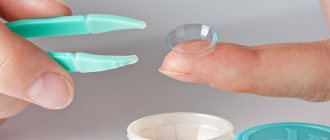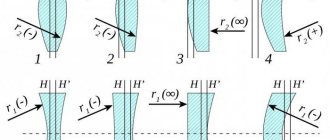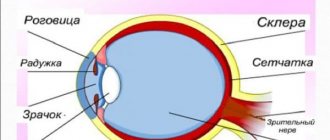Few things impact your quality of life more than the quality of your vision, so you should never take risks with your eye health. Proper care and regular replacement of contact lenses are crucial here.
To keep your eyes healthy, it is very important to choose the right contact lenses, including colored ones. An ophthalmologist will help you choose contact lenses that provide the necessary vision correction and suit your lifestyle. In order to take advantage of all the benefits that contact lenses provide, you must handle them correctly and follow the rules of care that your doctor will tell you about.
Not all contact lenses are the same. The choice of contact lenses depends on a number of factors - age, lifestyle, required visual correction, so only an ophthalmologist can choose the lenses that best suit you individually. The current range of contact lenses provides ample opportunities for contact lens wearers. Most modern contact lenses, such as ACUVUE brand frequent replacement contact lenses, provide excellent vision and eye health. Contact lenses are divided into two categories depending on whether you can leave them on at night or not.
What are extended wear contact lenses?
Extended wear contact lenses are optical devices that can be worn without removal for 30 days. Unlike daily wear lenses, they contain special substances that help moisturize the cornea of the eye and allow it to breathe. Thanks to these properties, extended wear lenses can be worn longer than other optical products.
In what cases should they be used?
Today, many users prefer continuous lens wear. Typically, this category includes people who travel frequently and spend a lot of time away from home, such as drivers.
They are unable to create sterile conditions for lens care, so they opt for such optical products. In addition, ophthalmologists sometimes themselves prescribe long-wear lenses for therapeutic purposes or after surgical interventions on the cornea.
Many patients are interested in the question: what is the difference between long-wear lenses and extended-wear lenses? Ophthalmologists answer their patients this way: with continuous mode, the lenses can remain on the cornea for a longer period of time. So, having put on optical correction devices once, you can forget about their presence for as long as 30 days. Extended lens wearing is continuous use of lenses for only 6 days.
Doctors strongly recommend periodically removing and cleaning your lenses for a month to give your eyes some rest and to disinfect the lenses.
Why is it so important to care for your lenses?
The eyeball is a fragile and delicate organ. Therefore, caring for night lenses, their daytime counterparts, soft and hard varieties is important: it reduces the risk of various inflammations and infections. Moreover, this also applies to those diseases that can lead to complete blindness. Ophthalmologists say that when wearing an optical device, a mucous substance can be deposited in the corners of the eyes, and fats and proteins can be deposited on the surface itself. Their number is very small and invisible from the outside. But your eyes are sensitive to them: visual acuity decreases, wearing lenses often becomes uncomfortable.
That's why proper lens care will help you avoid the problems described above. Moreover, in the 21st century, it does not require any special effort: you just need to go to the nearest pharmacy or specialty store and buy everything you need. The range includes a variety of lens cleaning products and solutions that help keep them in good condition. They save human resources: effort, time and money.
Their features and advantages
During long-term business trips and camping trips, continuous wear lenses will simply be a lifesaver for the user. How useful and safe they are can be judged by their features.
Of primary importance for long-term wear lenses is the material from which they are made. Standard soft contact lenses are typically made from hydrogel polymers. However, due to their low oxygen permeability, it is recommended to wear such lenses only during the daytime.
For continuous or prolonged use (usually a period of 7 to 30 days), silicone hydrogel contact lenses are used, which can be purchased at an optician on the recommendation of a specialist. They are soft and at the same time high oxygen permeability.
Gas-permeable contact lenses, hard or soft, are also allowed for long-term wear. They also allow oxygen to pass through, but are less soft compared to silicone hydrogel “brothers”. Their wearing period is up to 30 days.
Benefits of extended wear lenses:
- ease of wearing (no need to take it off or put it on regularly);
- comfort.
- affordable price.
Wearing rules
Continuous wear lenses require compliance with a number of rules:
- Swimming with lenses is not permitted.
- It is important to adhere to the terms of use of lenses. Even if they have only been worn a few times throughout the month, they should definitely be replaced. The service life of long-term wear lenses begins from the day the blister or bottle with the lens is opened.
- You should purchase a lens care solution along with your lenses.
- Before purchasing lenses, you should consult your doctor regarding individual tolerance and possible contraindications. For example, it is not recommended to use continuous wear lenses for dry eye syndrome (DES), various general diseases (flu, sore throat and even the common cold).
- You should not swim in long-term wear contact lenses.
When choosing lenses, you should not rely only on manufacturers' recommendations. Only a specialist with relevant experience can make an informed decision about the possibility of continuous wearing of contact lenses.
The doctor must take into account the individual characteristics of your eye and possible contraindications to wearing contact optics (chronic inflammation of the organ of vision, dry eye syndrome, etc.).
Other necessary means
These are salt solutions “Lycotine Universal” or “Lycotine Comfort”. They are used for storage and washing, as well as for processing the optical device using high temperature or ultraviolet light. Sometimes they are used together with effervescent soluble tablets or other means for disinfecting and cleaning lenses. You cannot use only saline solutions in daily care. Proper lens care can be done using cleaning devices - they disinfect with ultrasonic waves. First, the lens is treated with a multifunctional solution and only then placed in this device.
Speaking about lens care products, it is worth mentioning enzymatic cleaners. These are the same tablets that help remove excess protein deposits, dirt, dust and mucus from the surface of the optical device. Effervescent products easily dissolve in any cleaner and mix with it until they have a homogeneous structure. The lenses are dipped in them for 15 minutes, after which disinfectants are used.
Risks and complications
Studies have shown that the main cause of most complications with continuous lens wear is a lack of oxygen flow to the eye. The second reason is the difficulty in removing metabolic products, which is caused by both contact lenses and closed eyelids.
Insufficient oxygen flow during sleep causes metabolic disorders in the cornea of the eye. This leads to swelling and, as a consequence, to its thickening by about 5%. Greater swelling and thickening of the cornea is not normal and requires evaluation and appropriate treatment.
Previously, it was believed that for continuous wear, it was enough for lenses to have an oxygen permeability of 87 units.
This value was achieved with the advent of silicone hydrogel contact lenses. However, even after this innovation, the rate of complications remained high. Somewhat later, this figure was increased to 125 units, but this did not completely solve the problem. Today, manufacturers produce long-wear silicone hydrogel lenses with an oxygen permeability of 170 units. Such lenses can be called high quality. However, they do not guarantee safety if the user does not comply with wearing standards and lens care rules.
Illiterate use of contact lenses can lead to complications such as:
- red eye syndrome (associated with wearing lenses with insufficient gas permeability);
- corneal erosion (occurs due to dirt getting on the lens or damaging it);
- neoplasms of corneal vessels (appears due to prolonged corneal hypoxia);
- corneal edema (develops due to the toxicity of solutions);
- dry eye syndrome (caused by improper selection of lenses or individual intolerance);
- follicular conjunctivitis (develops with prolonged wearing of dirty lenses).
To avoid serious complications, it is necessary to follow all the recommendations of the ophthalmologist and undergo a timely preventive examination. Even if the lenses are recommended for continuous wear for a long time, they should be removed during infectious diseases (sore throat, flu, ARVI). When swimming, it is better to replace them with daily lenses, which should be thrown away immediately after leaving the water.
Features of storing different types of lenses
There are two types of optical devices: soft and hard. The first are made from polymer materials, hydrogels and silicone. They are flexible, plastic, and allow sufficient moisture and oxygen to pass through to the surface of the eye. Caring for soft contact lenses includes all the procedures described above. As for hard lenses, they consist of the same polymers, only denser. They are used for complex corneal defects: for example, to correct high degrees of astigmatism. Caring for hard lenses also requires the same solutions. Despite the fact that such devices are denser, they must be handled with care. They are very easy to damage due to their increased fragility and tendency to deformation.
Any type of lenses must be stored in a container. In appearance, these are two small round containers connected to each other by a thin partition. Usually each has a different color, so as not to confuse where the left and right parts are stored. Each section of the container is closed with a separate lid, thereby preventing the liquid from pouring out or evaporating. Change the container itself once a year.
Caring for long-term wear lenses
Caring for continuous wear lenses requires constant monitoring of dirt or dust getting into your eyes.
If you feel the slightest discomfort while wearing them, contact a specialist immediately. There is a possibility of individual intolerance to this type of lenses or there is a need to simply change the manufacturer.
Long-term wear contact lenses can be left in place at night until the expiration date specified by your ophthalmologist. Some lenses are recommended to be thrown away after removal, while others can be worn again after cleaning and disinfecting them. It is important to strictly follow the wearing regimen recommended by the ophthalmologist.
Soft contact lenses tint
Cleaning Contact Lenses
Did you know that proper cleaning and rinsing of contact lenses can remove up to 90% of bacteria found on lenses? It is best to clean and disinfect reusable soft contact lenses immediately after removal. To clean the lens, you typically place the lens on a clean, dry palm, apply a few drops of daily care solution, and use your little finger to gently rub the front and back surfaces of the lens.
The lenses are then thoroughly washed with lens care solution and placed in a special storage container. Fill the lens cells with the solution, close the lid and leave the lenses in the solution. Change the solution in the container regularly to fresh one according to the instructions for caring for contact lenses and the information on the package insert.
The hygiene of contact lens storage containers is often not given enough attention. After putting on the lenses, pour the solution out of the container, rinse the container with fresh disinfectant solution and leave to air dry during the day. It is very important to dry the container, since pathogenic microbes can only multiply in a humid environment. Lens storage containers should be changed frequently, ideally once a month. For more information on how to properly clean the container, please contact your ophthalmologist. By carefully following your doctor's recommendations, you will enjoy the comfort and excellent vision of your contact lenses.
Recommendations for users
To safely wear contact lenses, strict adherence to hygiene requirements is very important:
- Do not wear contact lenses for more than 30 days in a row.
- To replace lenses with a new pair, you should take a break of at least one night.
- Never use contact lenses longer than recommended by your ophthalmologist.
- Regular examinations by an ophthalmologist are necessary to ensure that contact lenses function well and maintain normal vision.
- If your eyes become red or irritated or you experience blurred or blurred vision, immediately remove your contact lenses and consult a doctor.
- Always carry glasses with you for emergency use.
- If you have to remove your contact lenses, do not put them back on without first cleaning, rinsing and disinfecting them.
- Do not continuously wear soft contact lenses in cases where there have previously been complications after eye surgery (cataract or laser correction, including myopia or astigmatism).
- After sleep, it is advisable to instill drops to lubricate and moisturize contact lenses.
- Wash your hands before removing, putting in, or cleaning contact lenses. Otherwise, everything on your hands will end up on your lenses, including bacteria and other pathogens.
- If you wear makeup, apply the makeup first and then put on your lenses. In the evening: first remove your lenses, and then remove your makeup (especially mascara). It is better to use water-based cosmetics (liquid powder, special mascara, etc.).
- Never use hairspray or other aerosols while wearing lenses! Seal your hair with hairspray before putting on your lenses. Do this in a different room.
For smokers: soft lenses absorb smoke, which has a bad effect on their oxygen permeability. If you still smoke with your lenses in, then at least change them more often.
conclusions
So, long-term wear contact lenses will be safe for you if you take a responsible attitude towards your health, that is, if you follow the rules of wearing and care. Let us once again recall the main points of these rules:
- Make the initial selection only from a good specialist.
- If you decide to change the brand of lenses, consult your doctor.
- Follow the terms and rules of wearing.
- Wear lenses with high oxygen permeability.
- From time to time, remove the lenses and give your eyes a rest, and disinfect the lenses in the solution.
If you follow these simple rules, you will find yourself in the category of long-wear lens wearers who are at minimal risk of developing complications.









